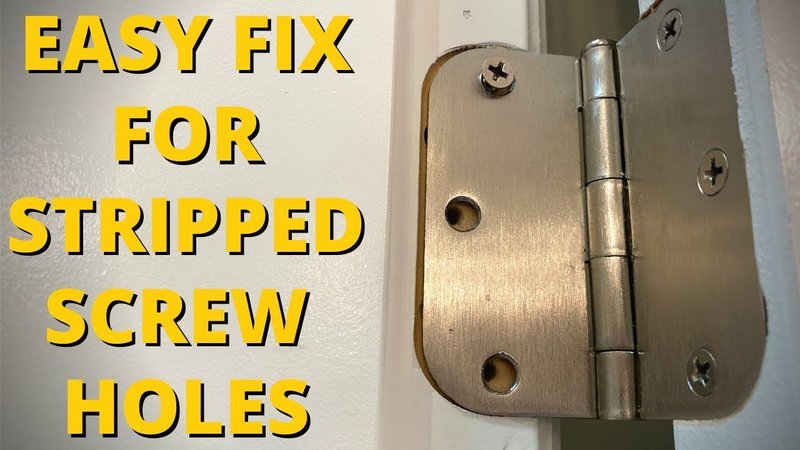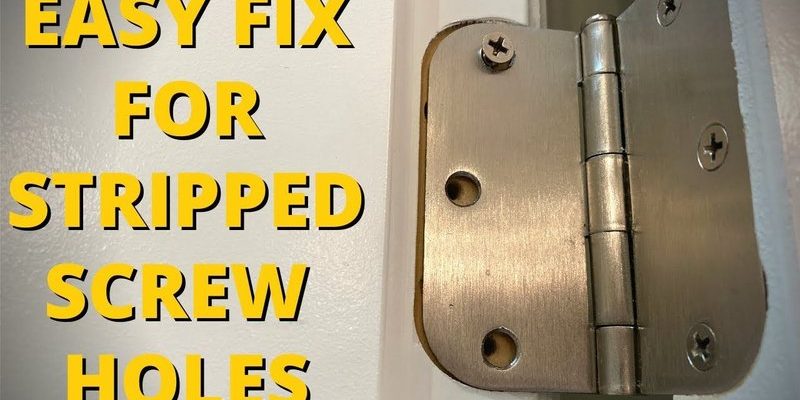
Here’s the thing: hinges are the “ankles” of your door. If they get loose, damaged, or out of alignment, the whole door sags, drags, and generally acts up. Most people assume you need a pro or a replacement, but repairing a door that’s dragging due to hinge issues is usually something you can handle with a screwdriver, a bit of patience, and a few tricks.
Let me explain how to spot what’s going wrong, fix it step by step, and keep your door swinging smoothly for years—no matter if you’re dealing with a brand-new steel entry door or a weathered, wood-paneled classic.
How Do Hinges Cause Doors to Drag?
If you’re wondering why your exterior door seems to be sticking at the bottom all of a sudden, blame the hinges. Over time, the daily opening and closing puts a lot of stress on them. Screws can loosen, hinges can warp, and the door might start to hang crooked on the frame. Sometimes, it’s as simple as gravity doing its slow, sneaky work. Other times, weather (like rain or humidity) can cause wood to swell and put extra pressure on the hardware.
Here’s the thing: when hinges aren’t doing their job, the top corner of the door usually starts to tilt down, pushing the bottom corner into the floor. If you see gaps at the top or side, or notice the door doesn’t line up with the frame, you’re almost certainly dealing with hinge problems.
You might notice:
- The door is hard to open or close.
- The bottom scrapes against the threshold or floor.
- You see visible gaps along the frame.
- Hinges look bent, loose, or rusty.
It’s frustrating, but most of the time, you won’t need to replace the whole door—just give those hinges some love.
Tools and Supplies You’ll Need to Fix Door Hinges
Before jumping into repairs, it helps to gather everything you’ll need. Don’t worry—no fancy tools are required. Most jobs can be done with things you already have in a basic toolbox. If you’re working on a heavy exterior door (especially a steel one), having a helper can make things a lot safer and easier.
Here’s what you’ll want on hand:
- Screwdriver (Phillips or flat-head): For tightening or replacing screws.
- Drill and drill bits: Useful if you need to reset screws or pre-drill holes.
- Wooden toothpicks, dowels, or glue: In case old screw holes are stripped.
- New hinge screws: Go for longer 2-3″ screws for better grip (especially into wall studs).
- Hammer and nail punch: If hinge pins are stuck or need to be tapped back into place.
- Shims or cardboard: For adjusting gaps or supporting the door during repair.
- Level: To check alignment if you want to be precise.
Honestly, if you can use a screwdriver and keep track of a few screws, you’re pretty much set. For most exterior doors—from Masonite fiberglass to JELD-WEN steel—the same toolkit will do the job.
Step-by-Step Fix: Tightening Loose Hinges
This is the most common, beginner-friendly fix for a dragging door. Most exterior doors sag simply because the screws in the top hinge have loosened over time. Fixing this is almost always the fastest way to get your door back to normal.
Here’s what to do:
- Open the door wide and inspect the hinges. Look for loose screws, gaps between the hinge and the frame, or wobbling parts. If you can move the door up and down by lifting the handle, your hinges are definitely loose.
- Tighten the screws with your screwdriver. Start at the top hinge—this one carries most of the door’s weight. A few turns are often enough. If the screw just spins without tightening, the hole may be stripped (I’ll explain how to fix this next).
- Check the door’s movement. After tightening, open and close the door a few times. If the dragging stops, you’re all set.
- Repeat for the other hinges. Even if only one hinge seems loose, go ahead and check all of them. On heavier doors, the bottom hinge sometimes works loose, too.
Let me tell you—I once fixed my front entry door with nothing but a screwdriver and 10 minutes. It felt like a mini victory every time I opened it afterward.
What to Do if Hinge Screws Won’t Tighten
You might be wondering: “What if the screws just spin in place and refuse to tighten?” That’s a sign the wood inside the door frame is stripped or worn out. This is super common, especially with older wooden jambs or doors that have seen a lot of weather.
Here’s the trick:
- Remove the hinge screw. Take out the loose screw entirely.
- Fill the hole. Push several wooden toothpicks (or a small dowel) dipped in carpenter’s glue into the hole. Break them off flush with the wood.
- Let it dry, then re-insert the screw. The toothpicks provide new “grip” for the screw, holding the hinge tight.
- For extra hold, use longer screws. Replace short screws with 2-3″ wood screws that reach deeper into the wall framing—not just the thin door jamb.
This little DIY hack works wonders and saves you from calling in a pro. For steel exterior doors, you’re usually dealing with a wooden or composite frame, so the same method works.
How to Realign Hinges for a Proper Door Swing
Sometimes tightening screws won’t fix everything—especially if the hinges themselves aren’t level or have shifted out of place. Ever notice a widening gap at the top or bottom of your door? Or maybe the locking latch doesn’t line up? You’re dealing with a misaligned hinge.
Here’s how you can realign your hinges:
- Check the gap. With the door closed, look along the edges for uneven spaces. The gap should be even all the way around.
- Loosen, don’t remove. Back out the screws on the offending hinge just enough that you can gently move it side to side.
- Adjust with shims if needed. Slip a piece of cardboard or a thin shim behind the hinge leaf (the side attached to the door or frame) to tweak the alignment. Even a tiny adjustment can make a huge difference.
- Retighten and test. Screw the hinge back down, then open and close the door several times to check the swing.
You can repeat this on any hinge that seems off. Honestly, it’s a bit like tuning a guitar—you might need to tweak each hinge a little bit before the door’s “in tune” and gliding smoothly.
Dealing with Damaged or Rusty Hinges on Exterior Doors
Exterior doors put up with a lot—rain, humidity, and temperature changes can do a number on metal hinges. Eventually, you might see rust, bent parts, or even a wobbly hinge pin that just won’t stay put. If the hinge looks rusty or physically damaged, it’s best to replace it instead of just tightening or adjusting.
Here’s what you’ll do:
- Remove the old hinge. Unscrew it from both the door and frame (support the door so it doesn’t swing or drop).
- Take the old hinge to a hardware store. Match the size, style, and screw placement for the new hinge. Most exterior doors, like those from Masonite or JELD-WEN, use standard-size hinges, but double-check to be sure.
- Install the new hinge. Attach it to the frame first, then to the door, tightening all screws securely. If needed, use the toothpick trick or extra-long screws for stripped holes.
- Check for smooth operation. Open and close the door a few times to make sure the problem’s solved.
A fresh hinge can make a world of difference—no more squeaks, drags, or stubborn sticking. Just remember, if one hinge is rusty or bent, check the others while you’re at it.
How Weather and Door Materials Affect Hinge Issues
Not every dragging door can be blamed purely on loose screws. Temperature and humidity swings can make wood doors expand and contract, pulling on hinges and throwing off alignment. Steel doors don’t swell, but their frames might, especially if they’re set in wood.
Wood moves with the seasons, and even a trusty steel door depends on what it’s mounted to. Think of it like wearing shoes that fit perfectly in winter, but feel tight in summer—sometimes the environment just messes things up.
- Wood doors: Most likely to drag after wet or humid spells. Let the door dry out, then recheck hinge alignment before making any permanent changes.
- Steel or fiberglass: Usually more stable, but their wooden frames can swell. If you see swelling or cracking near hinges, tighten up those screws, or add longer ones for more grip.
- Weatherstripping: Sometimes old, stiff weatherstripping can push the door off alignment. If you’ve fixed the hinges and it still drags, check the seals around your door.
Being aware of your door’s material and local climate gives you a leg up when troubleshooting and helps you prevent future hinge headaches.
Preventing Future Hinge Problems on Exterior Doors
Once you’ve got your door swinging smoothly again, a little regular maintenance can keep things that way. Think of it as routine “code” checks for your entryway—making sure everything’s paired, synced, and ready for daily use.
Try these simple steps every few months:
- Check for loose screws regularly. Give hinges a quick look and tighten anything that’s starting to wiggle.
- Lubricate hinge pins. A drop of household oil or silicone spray keeps squeaks away and helps prevent rust.
- Wipe away debris and moisture. Dirt and water can cause hinges to corrode or stick. Keep them clean, especially on stormy or muddy days.
- Replace weatherstripping if it’s stiff or damaged. Keeps your door sealing tightly and operating smoothly.
Honestly, a well-cared-for door hinge will outlast almost anything else on your entryway. With a bit of attention, you can avoid surprise repair jobs and keep your Masonite or JELD-WEN exterior door looking and working like new.
When It’s Time to Call a Pro for Door Repairs
Sometimes, despite your best efforts, a door just won’t behave. Maybe the frame is rotted, the door is badly warped, or nothing you try keeps the hinges tight. If you’ve replaced screws, realigned hinges, and tried all the DIY troubleshooting tips, but the problem keeps coming back, it might be time to call in a professional.
Here’s what usually means you need expert help:
- Significant rot or water damage around the hinge area—especially in wood frames.
- The entire frame is out of square, making it impossible to line up the door properly.
- Security concerns. For front entry doors, you want hinges that are truly solid—sometimes a pro installation is the best peace of mind.
- Repeated hinge “reset” issues, even after trying longer screws and hole-filling tricks.
Think of calling a pro like resetting a complex remote or re-coding a system: sometimes, you hit that point where experience and specialized tools make all the difference.
Wrapping Up: A Smooth-Swinging Exterior Door is Within Reach
Repairing an exterior door that’s dragging due to hinge issues might seem like a big hassle, but it’s honestly one of those satisfying, hands-on fixes you can do yourself. With a screwdriver, a few bits and bobs, and the troubleshooting steps above, you’ll have your entry door swinging smoothly in no time. Just remember, hinges are the heart of your door’s movement—keep them tight, clean, and rust-free, and you’ll avoid most of the usual headaches.
Whether you’re dealing with a classic wooden entry, a tough Masonite fiberglass, or a solid JELD-WEN steel door, most dragging problems trace right back to those small, hardworking hinges. Give them some attention and you’ll be rewarded every single time you open that door—coffee in hand, strongman routine not required.
